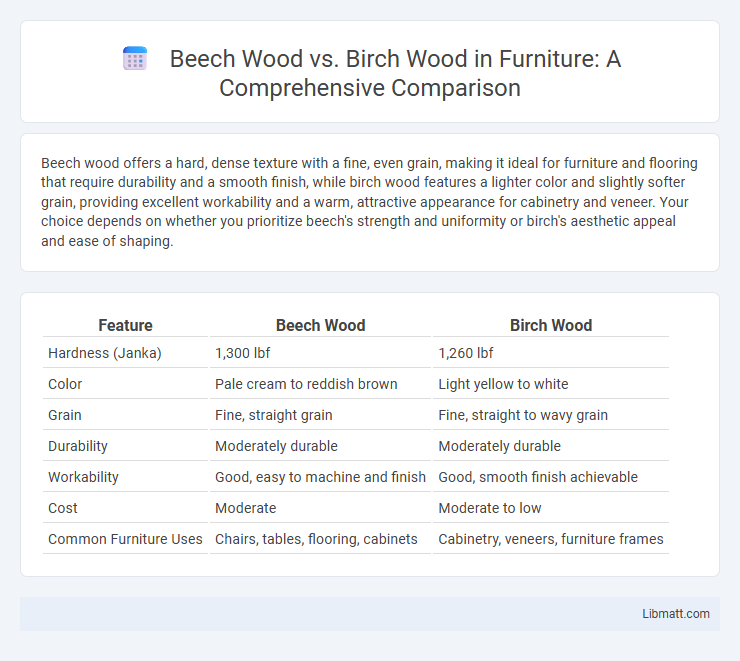Beech wood offers a hard, dense texture with a fine, even grain, making it ideal for furniture and flooring that require durability and a smooth finish, while birch wood features a lighter color and slightly softer grain, providing excellent workability and a warm, attractive appearance for cabinetry and veneer. Your choice depends on whether you prioritize beech's strength and uniformity or birch's aesthetic appeal and ease of shaping.
Table of Comparison
| Feature | Beech Wood | Birch Wood |
|---|---|---|
| Hardness (Janka) | 1,300 lbf | 1,260 lbf |
| Color | Pale cream to reddish brown | Light yellow to white |
| Grain | Fine, straight grain | Fine, straight to wavy grain |
| Durability | Moderately durable | Moderately durable |
| Workability | Good, easy to machine and finish | Good, smooth finish achievable |
| Cost | Moderate | Moderate to low |
| Common Furniture Uses | Chairs, tables, flooring, cabinets | Cabinetry, veneers, furniture frames |
Overview of Beech Wood and Birch Wood
Beech wood is a hard, strong hardwood known for its smooth texture and pale cream color, commonly used in furniture and flooring due to its durability and resistance to wear. Birch wood, typically lighter in tone with a fine grain, offers excellent shock resistance and is favored for cabinetry and plywood applications. Your choice between beech and birch wood depends on the specific project requirements, balancing aesthetic appeal with functional strength.
Botanical Origins and Growth Regions
Beech wood originates from the Fagus genus, primarily found in Europe, Asia, and North America, thriving in temperate climates with well-drained soils. Birch wood comes from the Betula genus, widespread across the Northern Hemisphere, particularly in cooler regions of Europe, Asia, and North America. Understanding the distinct botanical origins and growth regions of beech and birch wood can help you choose the right material for your woodworking or furniture projects.
Physical Appearance and Grain Patterns
Beech wood features a pale cream color with occasional pink or brown hues and displays a straight, fine-grained pattern with a smooth texture. Birch wood typically presents a light yellowish-white color, sometimes with reddish or brown streaks, and has a fine, even grain that can appear wavy or curly. Both woods are prized for their uniformity and subtle variations, making them popular for furniture and cabinetry requiring clean, attractive finishes.
Hardness and Durability Comparison
Beech wood has a Janka hardness rating of approximately 1,300 lbf, making it harder and more resistant to dents compared to birch wood, which averages around 1,260 lbf. In terms of durability, beech is denser and offers better wear resistance, making it ideal for heavy-use furniture and flooring. Birch wood, while slightly softer, still provides good durability but is more prone to surface scratches and dents over time.
Workability and Machining Characteristics
Beech wood offers excellent workability with a fine, even texture that allows smooth machining and reduces tool wear, making it ideal for furniture and flooring projects. Birch wood is also easy to machine but tends to have a slightly higher density and hardness, which can increase tool dulling and requires sharper cutting tools for precision. Both woods respond well to sanding and finishing, but beech's consistent grain pattern typically results in a cleaner surface during detailed woodworking tasks.
Common Applications and Uses
Beech wood is commonly used for furniture, flooring, and kitchen utensils due to its hardness, smooth texture, and fine grain, making it ideal for items requiring durability and a polished finish. Birch wood finds frequent application in cabinetry, plywood, and interior paneling, prized for its strength, pale color, and ease of staining, which suits decorative and structural projects. Both woods are favored in the woodworking industry for their distinct aesthetic qualities and mechanical properties, serving different functional and design requirements.
Cost and Availability
Beech wood is generally more affordable and widely available in Europe and North America due to its abundant supply, making it a cost-effective option for furniture and flooring projects. Birch wood, while slightly more expensive, is prized for its fine grain and strength, and is commonly sourced from Northern Hemisphere forests, which can sometimes limit availability and increase prices depending on the region. Both woods offer competitive pricing but beech wood's broader accessibility typically results in lower overall costs.
Environmental Impact and Sustainability
Beech wood is known for its fast growth and recyclability, making it an eco-friendly choice with a relatively low environmental impact compared to slower-growing hardwoods like birch. Birch wood, while durable and strong, often requires longer cultivation periods, which can result in greater resource consumption and habitat disruption. Your decision to use sustainably sourced beech wood supports responsible forestry practices and reduces ecological footprints.
Maintenance and Longevity
Beech wood is dense and durable, offering excellent resistance to wear and requiring minimal maintenance to maintain its smooth finish over time. Birch wood, while also strong, is more susceptible to dents and scratches, necessitating more frequent care such as sealing or refinishing to preserve its appearance. Your choice between beech and birch will impact the effort needed to sustain the wood's longevity and aesthetic in high-traffic or furniture applications.
Choosing the Right Wood for Your Project
Beech wood offers a dense, hard texture ideal for flooring and furniture that require durability and smooth finishes, while birch wood provides a fine grain and pale color, making it suitable for cabinetry and interior paneling where aesthetics are key. Beech has excellent shock resistance and machines well, lending itself to heavily used items, whereas birch is easier to stain and paints evenly for customizable design. Selecting between beech and birch depends on the balance between hardness, workability, and the desired final appearance for your project.
beech wood vs birch wood Infographic

 libmatt.com
libmatt.com